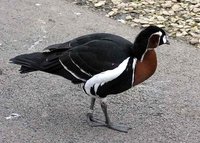Red-breasted Goose
|
|
| Red-breasted Goose Conservation status: Vulnerable | ||||||||||||||
|---|---|---|---|---|---|---|---|---|---|---|---|---|---|---|
 | ||||||||||||||
| Scientific classification | ||||||||||||||
| ||||||||||||||
| Binomial name | ||||||||||||||
| Branta ruficollis (Pallas, 1769) |
The Red-breasted Goose (Branta ruficollis) is a goose of the genus Branta, closely related to the Brent Goose (Branta bernicla).
All the species of the Branta genus are distinguished by their general dark sooty colour, relieved in some by way by white of greater or less purity, and as a distinction from the members of the genus Anser, which are known as grey geese.
The Red-breasted Goose breeds in arctic Europe, often close to nests of large birds of prey, such as Peregrine Falcons. This helps to protect this small goose from predators such as the Arctic Fox.
The goose winters in south eastern Europe. It is a rare vagrant to Britain and other western European countries, where odd birds are sometimes found with Brent flocks.
The bird is unmistakable, but can be surprisingly difficult to find amongst Brent Geese due to its small size. The red also tends to look black at long distances.
The Red-breasted Goose is officially classed as Vulnerable as over 80% of the population roost during the winter at just five sites, with nearby feeding areas threatened by changes in land-use.bg:Червеногуша гъска de:Rothalsgans eo:Ruĝkola ansero fr:Bernache à cou roux lt:Rudakaklė berniklė pl:Bernikla rdzawoszyja fi:Punakaulahanhi
